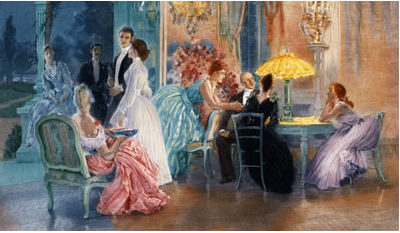
Courtesy counts
礼貌为重
The Brown and Levinson model says, roughly speaking, that Person A probably does not want to be rude to Person B, but in the way of things, life may sometimes require Person A to contradict or intrude on Person B, and when that happens, Person A has a range of "politeness strategies" to draw on. There are four main possibilities, given in ascending order of politeness. The first is a "bald, on-record" approach: "I'm going to shut the window." The second is positive politeness, or a show of respect: "I'm going to shut the window, is that OK?" The third is negative politeness, which presumes that the request will be an intrusion or an inconvenience: "I'm sorry to disturb you, but I want to shut the window." The fourth is an indirect strategy which does not insist on a course of action at all: "Gosh, it's cold in here."
大致讲来,Brown和Levinson模型说到,人物A大概并不想让人物B觉得自己粗俗,但就事论事,生活有的时候会让人物A与人物B两相抵触或者是强弱相施。而当这种情形发生之时,人物A会采取一系列的"礼貌策略"。按照礼貌不同程度来上升排列,主要有四种可能的策略。首先是"不加掩饰的,记录在案的"方式:"我会要关上这个窗子",第二个是积极的礼貌,或者以示尊重:"我会要关上这个窗子,好吗?",第三种是消极的礼貌,这种情形下,假定了要求会受到打扰或者引起不便:"很抱歉打扰你,但我要关上窗子"。第四种是一种间接的策略,并不完全坚持对行为的导向:"哎呀,这里冷呀"。
The first three of those options are plain instrumental speech, and are the sort of approaches that the conversation manuals warn you against. The fourth one alone leads into the realm of conversation as such. Here the purpose of speaking is not so much to get a point across, more to find out what others think about it. This principle of co-operation is one of the things that sets conversation apart from other superficially similar activities such as lectures, debates, arguments and meetings. Other qualities which help to define conversation include the equal distribution of speaker rights; mutual respect among speakers; spontaneity and informality; and a non-businesslike ambience. The last of these was well caught by Johnson when he defined conversation as "talk beyond that which is necessary to the purposes of actual business".
以上选择的前三种都是平铺直叙式的功能性语言,都归属在会话手册上警告过的不要违反的方式类型之中。单只有第四种在谈吐的王国内登堂入室。比起找出其他人对某种观点是怎么想的来,演讲的目的并不是那么注重把某种观点讲得通透这一点。从某一个方面出发,将会话与其它某些肤浅的类似活动:讲课,辩论,讨论和会议有所区别的是合作的原则。其它有助于明确定义"会话"的特征包括:说话人之间的相互尊重;自然随意性和非正式性;非商务式的环境。这些中的最后一条为Johnson所捕捉到,在他对"会话"的定义中"言谈,必须是超越商业实务目的之上的"。
If conversation, and politeness, do have common features across time and culture, it is not all that surprising that newer manuals will find little to add in terms of fundamental principles. They can, however, offer specific tips which are useful in the right circumstances, and these, too, change little with the years. "Never recount your dreams in public," wrote the anonymous author of "Maximes de la Bienséance en la Conversation", one of the first manuals of conversation published in France, in 1618. Margaret Shepherd, author of "The Art of Civilized Conversation", a manual published in America in 2006, offers the same prohibition. Among the ill-judged remarks that she calls "saboteurs of small talk", she includes "self-absorbed comments like ‘I had the strangest dream. You were in it. Uh, let me try to remember it’."
如果谈吐和礼仪在时间和文明之间有着共同的特征;也就是完全不用对新近的手册里对基础性原则几无增益感到吃惊。他们能够做到的是提供特定的环境之下的具体招术——而这,也是多年未有变化了。1618年,无名氏在第一本以法语刊布会话手册《言谈礼仪格言(Maximes de la Bienséance en la Conversation)》中写到:"绝不要在公共场合不厌其烦的大谈特谈自己的梦想"。《文明会话的艺术(The Art of Civilized Conversation)》于2006年在美国出版,手册也提供了同样的禁止事项,作者为Margaret Shepherd。Margaret Shepherd把那些偏颇(欠思量)的评论叫做"一带而过的消极分子",把"自顾自的评论"总括为"像是’我做过的最稀奇古怪的梦,你就在这个梦里头,嗯,那就让我试着记住它吧’"。
The more modern the manual of conversation, the more concrete its advice is likely to be. Ms Shepherd offers seven quick ways to tell if you are boring your listeners, which include: "Never speak uninterrupted for more than four minutes at a time" and "If you are the only person who still has a plate full of food, stop talking." Her checklist of things best not said to the parent of a newborn baby should be memorised for future use. It comprises: "What's wrong with his nose?" "Should he be that colour?" "Isn't he awfully small?" "Shouldn't you be breast-feeding?" "Did you want a boy?" "Is he a good baby?" "He looks like Churchill!/She looks like ET!" "It's really cute!"
会话手册越是摩登现代,建议也就越有可能具体实在。Shepherd女士提供七大捷径,以判断"是不是在让聆听者变得厌烦无聊",这包括:"绝不要一发言就口若悬河、滔滔不绝,一说就超过4分钟"和"如果你是唯一盘子里还盛满了食物的一个,停下来,别说了"。她给那些应该记忆下来以备将来使用的,最好别对幼子孩童的父母说的事宜开立了核查清单。其内包括:"他的鼻子怎么啦?""她该穿着这个色吗?""他不是个头太小了吧?""你就不能母乳喂养吗?""你想要个男娃吗?""小男孩乖吗?""他看上去像丘吉尔!/她看上去像外星人(ET)!""真的很机灵(cute :Q)!"
It is easy enough to see the usefulness of such tips, but they capture none of the joy which comes from the mastery of conversation. For enthusiasts conversation is an art, one of the great pleasures of life, even the basis of civilised society. Mme de Staël, a great talker and intellectual of the French ancien régime, called conversation "a means of reciprocally and rapidly giving one another pleasure; of speaking just as quickly as one thinks; of spontaneously enjoying one's self; of being applauded without working...[A] sort of electricity that causes sparks to fly, and that relieves some people of the burden of their excess vivacity and awakens others from a state of painful apathy".
能看出这些提示的有用之处是很容易的,但这些提示一点也没有捕捉到来自高超的会话技艺上的欢乐。对于痴心之人(好这一口的人)来说,谈吐就是一种艺术,就是人生最大乐趣之一,甚至还是文明社会的基础。旧法国政权下的知识分子和伟大的言谈家Mme de Staël就将会话称为"一种交互的快速的给予对方快乐的途径;一个人的谈吐就如他的思考一般的敏捷;一个人对自我的自发陶醉;一种不劳而获的称誉……一种激发出四溢的火花,它释放某些人的过量的活跃力的负担、从痛苦的冷漠状态中唤醒另外一些人的电流。"
The Athens of Socrates and Plato, in the 5th and 4th centuries BC, is often seen as home to a first golden age of conversation. That view has relied mainly on the writings of Plato, whose dialogues, often with Socrates as speaker, constitute "a search among friends...for the divine ideas of the true, the beautiful, the good", says a modern French scholar, Marc Fumaroli.
公元前5世纪和4世纪的苏格拉底和柏拉图所在的希腊,通常被视作是谈吐的第一次黄金时代的家园。这一观念主要的基于柏拉图的著作《对话录》,书中的苏格拉底通常是说话人,构建出"一种在朋友之间的搜寻……对真善美的神圣观点"。现代法国学者Marc Fumaroli如此说到。












